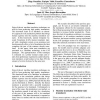94 search results - page 4 / 19 » Fragment Completion in Humans and Machines |
EMNLP
2004
13 years 8 months ago
2004
State-of-the-art machine translation techniques are still far from producing high quality translations. This drawback leads us to introduce an alternative approach to the translat...
VR
2003
IEEE
14 years 21 days ago
2003
IEEE
We examine the law of steering – a quantitative model of human movement time in relation to path width and length previously established in hand drawing movement – in a VR loc...
TOG
2012
11 years 10 months ago
2012
Humans have used sketching to depict our visual world since prehistoric times. Even today, sketching is possibly the only rendering technique readily available to all humans. This...
EDBT
2010
ACM
14 years 2 months ago
2010
ACM
With the advent of next-generation DNA sequencing machines, there is an increasing need for the development of computational tools that can anchor accurately and expediently the m...
BMCBI
2005
13 years 7 months ago
2005
Background: Within the emerging field of text mining and statistical natural language processing (NLP) applied to biomedical articles, a broad variety of techniques have been deve...

